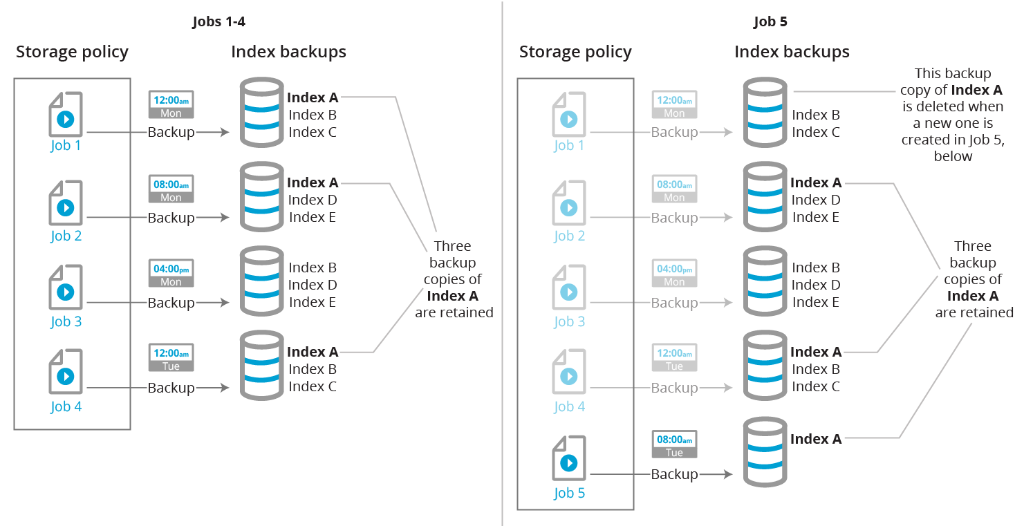The Indexing Version 2 creation and backup operations generate substantial amounts of indexing data. When this data is no longer required, the active index, index backups, action logs, and action log backups undergo a series of cleanup and compaction processes, described below.
Index Backup Cleanup
The system retains and deletes index backups according to the following rules:
-
If no secondary copy is associated with the IndexBackup storage policy, the three most recent backed-up versions of each index (per storage policy) are retained on the primary backup storage. When a fourth backed-up version of a particular index is retained, the oldest existing backed-up version of that same index is deleted from the backup storage when the cleanup operation is performed.
For example, the diagram below shows a storage policy running a series of jobs every 8 hours. These jobs back up Index A, Index B, Index C, Index D, and Index E.
-
During Job 1, Job 2, and Job 4 (left side of diagram) three individual backed-up versions of Index A are created.
-
During Job 5 (right side of diagram), another version of Index A is backed up. Because it is the fourth backed-up version of Index A, the oldest existing backed-up version of Index A (created by Job 1) is deleted from storage during cleanup.

-
-
If a secondary copy is associated with the IndexBackup storage policy, retention of index backups proceeds according to the following rules:
-
If all index data on the primary copy is copied to secondary storage, the three most recent backed-up versions of an index (per storage policy) are retained on both the primary storage and the secondary storage.
-
An index backup on the primary copy is deleted only when more than three backed-up versions of an index (per storage policy) exist on the secondary storage.
-
If only part of a backed-up version of an index on the primary storage is copied to secondary storage, the secondary storage retains the three most recent versions of that index (per storage policy) that were previously copied to it. Index backups present only on primary storage are not deleted from primary storage until more than three full backed-up versions of an index (per storage policy) exist on the primary storage.
-
Note
If tape media is used, and the Show aged data during browse and recovery option is selected in the Browse/Search/Recovery Options dialog box in the Control Panel, the aged backup jobs are treated as valid (that is, you can still browse and restore data from those jobs even though they are aged ) until the tape media is overwritten. The corresponding index backups are also retained as long as the aged backup jobs are valid.
Action Log Cleanup
The system deletes action log backups according to the following rules:
-
After an index backup completes, the individual action logs that were used to create the index that was backed up are deleted from the MediaAgent's index cache.
-
After an index backup is deleted from primary backup storage (following the rules shown above in Index Backup Cleanup), the backed-up action logs associated with that index backup are deleted from primary storage.
Note
If index backups are stopped, action logs are not deleted. This can result in unexpected index cache growth.
Index Cleanup
The system retains the active index in the MediaAgent's index cache indefinitely so that it can be accessed during operations such as browse and find, and reporting. During data backup jobs, the system writes new action logs into the index, thus keeping the active index continuously updated.
Note
The system never deletes an active index from the index cache during normal operations. However, if a user deletes a backup set from a client, the system deletes the index associates with that backup set.
When the system ages off backed-up data via retention rules, the system flags that data and deletes its associated metadata from the active index. This process, called compaction, decreases the size of the index and frees up storage space.